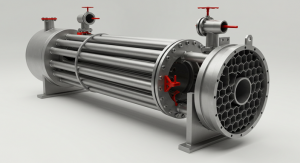A tubular heat exchanger is a crucial component in many industrial systems where efficient heat transfer between fluids is necessary. Industries like oil and gas, chemical processing, power generation, and food and beverage rely heavily on this equipment due to its durability and high performance.
How Does a Tubular Heat Exchanger Work?
In a tubular heat exchanger, one fluid flows through a set of tubes while another fluid flows around these tubes within a shell. Heat transfers between the two fluids, either to cool or heat one of them, depending on the application. These devices operate based on the principle of thermal conduction, where heat moves from the hotter fluid to the cooler one without direct contact between them.
The most common design is the shell-and-tube configuration. Engineers customize tube designs, lengths, and materials based on fluid properties, pressure levels, and temperature ranges to optimize performance.
Types of Tubular Heat Exchangers
There are several types of tubular heat exchangers:
- Single-pass tubular exchangers – where the fluid flows in one direction.
- Multi-pass designs – the fluid passes through the exchanger multiple times to enhance heat transfer.
- U-tube configurations – feature a U-shaped tube bundle allowing for thermal expansion and compact design.
Key Applications
Tubular heat exchangers serve a wide range of industries:
- Petrochemical – for cooling and heating chemical fluids under extreme conditions.
- HVAC – used in heating, ventilation, and air conditioning systems to regulate temperature efficiently.
- Food & Beverage – for pasteurization and sterilization processes without contamination.
- Power Generation – to recover heat from exhaust gases or generate steam.
Benefits of Using Tubular Heat Exchangers
Industries choose tubular heat exchangers for many compelling reasons:
- High Thermal Efficiency – They enable effective heat exchange with minimal energy loss.
- Robust Design – Constructed with stainless steel, copper, or other corrosion-resistant materials, they withstand harsh environments.
- Easy Maintenance – Their modular design makes cleaning and inspection simple.
- Scalability – Available in various sizes to suit different flow rates and thermal loads.
Materials Used in Tubular Heat Exchangers
The choice of material significantly affects the performance and longevity of the heat exchanger. Common materials include:
- Stainless Steel – Offers excellent resistance to corrosion and high temperatures.
- Copper – Excellent heat conductivity but limited by corrosion issues in some fluids.
- Titanium – Used in marine applications due to superior corrosion resistance to seawater.
Maintenance Tips
To ensure optimal performance and extend the lifespan of a tubular heat exchanger:
- Regularly clean the tubes to prevent fouling.
- Check for pressure drops which might indicate blockage or corrosion.
- Inspect for any signs of leakage or cracks in the tubes.
Why Choose a Tubular Heat Exchanger?
If you’re looking for reliability and performance, the tubular heat exchanger from Metalindo Engineering is an excellent choice. They offer high-quality, custom-engineered solutions tailored to your industrial needs.
FAQs About Tubular Heat Exchangers
What is a tubular heat exchanger used for?
It is used for transferring heat between two fluids, commonly in chemical plants, refineries, food processing units, and HVAC systems.
How do I choose the right tubular heat exchanger?
Consider factors like operating temperature, pressure, flow rate, fluid compatibility, and available space. Consulting with an experienced manufacturer can help.
What are the disadvantages of tubular heat exchangers?
They can be bulkier than plate heat exchangers and may require more space for installation. However, they offer better durability and performance in many heavy-duty applications.
How often should tubular heat exchangers be cleaned?
The frequency depends on the application, fluid type, and operating conditions. Regular inspection is recommended every 6 to 12 months.
Can a tubular heat exchanger handle corrosive fluids?
Yes, if constructed with appropriate materials like titanium or high-grade stainless steel, they can effectively handle corrosive environments.
Conclusion
A tubular heat exchanger offers efficient heat transfer, excellent durability, and adaptability for a wide range of industrial applications. Whether you need to cool down a fluid stream or recover energy, this type of heat exchanger delivers reliable performance under challenging conditions. Investing in the right design ensures not only energy savings but also long-term operational efficiency.
